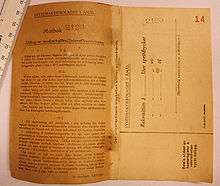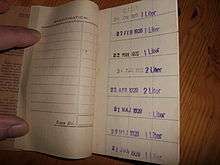Bratt System


The Bratt System was a Swedish system which was used during 1917 – 1955 to control alcohol consumption, by rationing of liquor. Every citizen allowed to consume alcohol was given a booklet called motbok in which a stamp was added each time a purchase on Systembolaget was made. The stamps were based on the amount of alcohol bought. When a certain amount of alcohol had been bought, the owner of the booklet had to wait until next month to buy more.
Wine was exempt from rationing, as it was considered less dangerous with little or no correlation to alcohol-related abuse or violence. Citizens made frequent use of friends' or even strangers' booklets, for example by rewarding a young woman with a dinner out in return for the other party consuming most or all of the alcohol incurring the stamps. The rations were gradually changed, but were issued in greater quantities to men (due to the lesser effects incurred on a male of equal or lesser weight) and citizens of titles and professions associated with a higher social standing.
Named after MD and politician Ivan Bratt, the Bratt system, involving the motbok, was made permanent in 1922 after referendum on a total ban on alcohol had been held. In this vote, a narrow 51% had voted no to banning alcohol sales. Its primary purpose was to decrease the consumption of alcohol. While a motbok owner could buy almost unlimited amounts of wine, spirits were highly restricted.
As of December 31, 1948, the average allowed purchase amount per motbok per month was 1.82 litres of spirits.
Sources
- Nationalencyklopedin, 2007
See also
| Wikimedia Commons has media related to Motbok. |